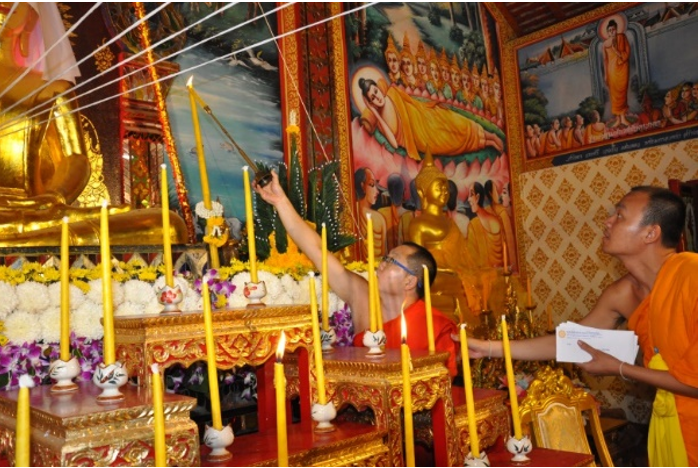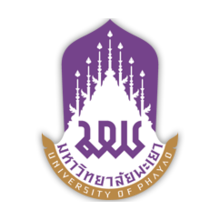The MahaBhuddhathaphisek Ceremony at Salachai Temple, Sala Subdistrict, Kokha District, Lampang Province: The Process of Performing and Symbolic Representations of Ritual
Keywords:
MahaBhuddhathaphisek Ceremony, Process of Performing the Ceremony, Symbolic Approach, Salachai TempleAbstract
The study aimed to study the process of performing and symbolic representations in the MahaBhuddhathaphisek ceremony at Salachai temple, Sala subdistrict, Kokha district, Lampang province by using in-depth interviews and participatory observation. The study indicated that this ceremony was held to celebrate on the occasion that the temple had been founded for 100 years, including the completion of the reconstruction of the temple and the principal Buddha image of the temple.
The ceremony was conducted for 3 days. The first day was known as the day of preparation, there was a procession to invite PhraUpakut for being the Guardian of the ceremony without any obstacles. The second day was the ceremony day, the first part started by having the eyes closed of the principal Buddha image, later it was a prayer ceremony called "SuadMonTan". As for the ceremony in the second period, it was opening ceremony of the principal Buddha's eyes which proceeded according to the sequence of steps specified until the end on the morning of the third day. And on the third day of the ceremony, there was a merit making ceremony dedicated to Thai alms, and there was a procession to invite PhraUpakut to his original location. Therefore considered as the completion of the MahaBhuddhathaphisek ceremony.
The symbolic representations that appeared in the MahaBhuddhathaphisek ceremony include 1) PhraUpakut was a sign of peace and order without all dangers 2) Khanhakothak was a sign of humility 3) Khantang was a symbol ofauspiciousness 4) the opening ceremony of the principal Buddha' s eyes was a sign of finding the light that meant the intelligence in life and 5) Khawmathupayas was a sign of perseverance and determination.
References
จารุวรรณ ธรรมวัตร. (2530). คติชาวบ้านอีสาน. กรุงเทพฯ: อักษรวัฒนา.
ฉัตรสุมาลย์ กบิลสิงห์. (2530). คติพิธีกรรมความเชื่อของคนไทยในจังหวัดนครปฐม. ในเพ็ญศรี ดุ๊กและคนอื่น ๆ (บรรณาธิการ). วัฒนธรรมพื้นบ้าน: คติความเชื่อ. กรุงเทพฯ : สำนักพิมพ์แห่งจุฬาลงกรณ์มหาวิทยาลัย, 109- 125.
ชาย ธรรมฺโม. (2544). ฉลาดทำบุญ. กรุงเทพฯ: สำนักพิมพ์เครือข่ายชาวพุทธ.
เดือน คำดี. (2541). ศาสนศาสตร์. กรุงเทพฯ: สำนักพิมพ์มหาวิทยาลัยเกษตรศาสตร์.
นฤพนธ์ ด้วงวิเศษ (2560). แนวคิดมานุษยวิทยากับการศึกษาความเชื่อสิ่งศักดิ์สิทธิ์ในสังคมไทย. วารสารมนุษยศาสตร์และสังคมศาสตร์, 25(47), 114-119.
ยศ สันตสมบัติ. (2544). มนุษย์กับวัฒนธรรม (พิมพ์ครั้งที่ 3). กรุงเทพฯ: สำนักพิมพ์.
มหาวิทยาลัยธรรมศาสตร์.ราชบัณฑิตยสถาน. (2556). พจนานุกรมฉบับราชบัณฑิตยสถาน พ.ศ.2554 (พิมพ์ครั้งที่ 2). กรุงเทพฯ: ราชบัณฑิตยสถาน.
วงเดือน ทองเจียว. (2545). ความเชื่อเรื่องบุญและพิธีกรรมเกี่ยวกับอุโบสถของชาวพุทธในเขตจังหวัดสุพรรณบุรี. (วิทยานิพนธ์ศิลปศาสตรมหาบัณฑิต). มหาสารคาม:มหาวิทยาลัยมหาสารคาม.
อนุมานราชธน, พระยา. (2506). วัฒนธรรมและประเพณีต่าง ๆ ของไทยด้วยเสฐียรโกเศศ(พิมพ์ครั้งที่ 3). กรุงเทพฯ: ก้าวหน้า.
อารีย์ ธรรมโคร่ง และ อ้อมใจ วงษ์มณฑา. (2562). พิธีกรรมความเชื่อเกี่ยวกับการเกิดและการตายของชาวบ้านไทยพุทธในอำเภอสายบุรีและอำเภอปะนาเระ จังหวัดปัตตานี. วารสารภาษา ศาสนาและวัฒนธรรม, 8(1), 110-135.
Morris, Brian. (2006). Religion and Anthropology: A Critical Introduction. Cambridge: Cambridge University Press.

Downloads
Published
How to Cite
Issue
Section
License
Copyright (c) 2021 Phayao University

This work is licensed under a Creative Commons Attribution-NonCommercial-NoDerivatives 4.0 International License.
ผู้นิพนธ์ต้องรับผิดชอบข้อความในบทนิพนธ์ของตน มหาวิทยาลัยพะเยาไม่จำเป็นต้องเห็นด้วยกับบทความที่ตีพิมพ์เสมอไป ผู้สนใจสามารถคัดลอก และนำไปใช้ได้ แต่จะต้องขออนุมัติเจ้าของ และได้รับการอนุมัติเป็นลายลักษณ์อักษรก่อน พร้อมกับมีการอ้างอิงและกล่าวคำขอบคุณให้ถูกต้องด้วย
The authors are themselves responsible for their contents. Signed articles may not always reflect the opinion of University of Phayao. The articles can be reproduced and reprinted, provided that permission is given by the authors and acknowledgement must be given.







